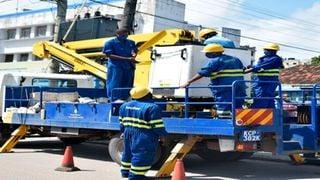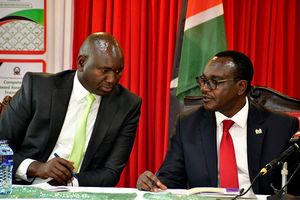
Kenya Power technicians carry out repairs on a transformer on Haile Selassie Road in Mombasa on December 5, 2020.
| File | Nation Media GroupCompanies
Premium
How Kenya Power sank from making billions in profits to financial darkness
What you need to know:
- Ms Rosemary Oduor is inheriting a company that posted a staggering Sh3 billion loss in the last financial year.
- Expensive power purchase deals and expansion of infrastructure without corresponding rise in electricity demand among the reasons monopoly is mired in debts.
When Mr Bernard Ngugi was appointed the Kenya Power chief executive officer on October 29, 2019, he promised to ensure the company’s business sustainability and make money for the shareholders.
He didn’t. As he might have found out, Kenya Power was in deep trouble.
But 21 months later, Mr Ngugi has either been shown the door – or simply jumped out – as the company continues to sink into financial blackouts, debts and possible collapse.
And in the regular game of musical chairs at the listed company, the board yesterday announced that it had appointed Ms Rosemary Oduor as the acting managing director and chief executive. The statement said that Mr Ngugi “resigned” after working with the company for 32 years.
With the exit of Mr Ngugi, Ms Oduor is inheriting financial turmoil at a company that posted a Sh3 billion loss in the last financial year – despite being a monopoly. It was the first loss in 17 years.
And now, a Cabinet memorandum drawn by the National Treasury has revealed the deep financial mess at the company that paints a picture of an entity on life support.
How the monopoly has fallen from a profitable entity, that raked in more than Sh130 billion in revenues to a loss-making entity that is burning all the cash, has intrigued investigators who are trying to unravel what went wrong. For now, Kenya Power can only survive with a bailout from the taxpayers – and the hard-pressed Treasury is also feeling the burden.
To stay afloat, Kenya Power is depending on overdrafts to pay salaries and finance working capital, as it totters towards bankruptcy. It is seeking the help of Treasury to turn its debts into equity. The Treasury will form a team to restructure the debts.
The Treasury document seen by the Nation reveals that what was once a cash rich parastatal – stripped to the bone by the Kanu regime and rescued by the Mwai Kibaki administration – has consumed all the billions it had in its reserves. Now, it is almost bankrupt and is unable to pay suppliers and lenders and meet obligations of shareholders.
“Kenya Power is facing serious financial challenges and is unable to meet her current obligations to suppliers, lenders and shareholders,” the document prepared by Treasury Cabinet Secretary Ukur Yatani advising the Cabinet on what must be done to rescue the company from imminent collapse reads in part.
Power Purchase Agreements
While much of this is attributed to purchase of expensive power, it is also blamed on cartels that have invaded the power sector, where they control the multi-billion-shilling procurement. As a result, Kenya Power is the bastion of dead stocks, theft of power and expensive power purchase agreements.
So serious is the financial position that the Kenya Power board, chaired by Ms Vivienne Yeda – with the support of the government – had formed a “war room” to deal with theft of power, especially by heavy consumers, who do so in collusion with company insiders.
In the past three months, a multi-agency team has been raiding some of these consumers who owed the company billions of shillings, and disconnecting the supply to some of the factories that have been at the centre of this intricate scheme.
The most affected areas are Nairobi’s Ruaraka and the Industrial Area. It is estimated that out of 25 per cent of the system losses, about 12.5 per cent relates to commercial theft by well-known companies and associated with well-known personalities.
Insiders say that it had been agreed Kenya Power had been asked to meter the transformers around industrial areas and other heavy consumers to determine the level of theft which amounts to billions of shillings every month.
At the end of June, Kenya Power executives had been tasked with providing the board, and the Dr Fred Matiang’i-chaired National Development Implementation and Communication Committee (NDICC), with a list of names of all the “rogue customers”. NDICC was constituted in January 2019 by President Kenyatta to oversee the delivery and oversight on government projects.
It has also emerged that Kenya Power has signed expensive Power Purchase Agreements (PPAs) and that the installed capacity is greater than the peak demand. In essence, the Kenya Power data indicates, the total installed generation capacity now stands at 2,788MW against a peak demand of 1,976MW.
It is due to this that the government in April 2021 was forced to suspend the signing of new PPAs as President Kenyatta formed a task force, chaired by Mr John Ngumi, and whose task was to develop the terms of reference and strategy for power purchase agreement.
But Kenya Power has been asking the government to approve some power purchase agreements and has been caught in a fix.
Sometime in May 2021, the board had approved a supplemental agreement seeking to revise the tariffs with Ethiopia from the existing US cents 8/kwh to 13/kwh plus a demand charge of US$4.84/kwh. This is to supply power to the border towns of Moyale and Sololo which would be without power if Kenya Power is unable to purchase power from Ethiopia.
Increasing costs
More so, the construction of the high-voltage Olkaria–Lessos–Kisumu 400/220/132KV transmission line, which was to improve quality of power in western Kenya, has been embroiled in court cases over compensation, thus delaying the project. As a result, the cash-strapped Kenya Power will have to enter into another PPA with Uganda Electricity Transmission Company at a cost of US$10/kwh.
While the entities in Uganda and Ethiopia are government parastatals, it is the independent power producers who have been accused of entering into wayward agreements; devoid of the rules of supply and demand.
By paying for installed capacity, which is not utilised, Kenya Power has been throwing away good money. The company first slipped into the loss-making territory in the year ended June 2020, when it reported a Sh2.98 billion loss. It has remained in the red since then, ending a 17-year profitability run.
The treasury document notes that over the past five years, the company has experienced a general decline in its financial performance driven by increasing costs and constrained growth in demand. But it points the biggest finger to the take or pay pricing model for the Power Purchase Agreements (PPAs) signed with Independent Power Producers.
These agreements have become a huge burden to Kenya Power, given that they have resulted in fixed capacity charges that become unfavourable to Kenya Power as the off taker irrespective of a cheaper source of electricity from Kengen. Thus, Kenya Power is forced to buy expensive power – even when Kengen has cheaper power – thanks to these agreements.
Whereas Kengen gives Kenya Power 71.7 percent of all the energy it distributes, its costs proportion only works to 48.3 percent. On the contrary, the independent power producers, who only supply 26.5 percent of power, account for 47.6 percent of the proportion of costs, in a major rip off of power consumers.
To bridge this gap, it is the consumer who is usually overcharged.
Treasury has also raised concerns over the huge finance costs and debt portfolio that are drowning the company.
“The huge debt portfolio was contracted to finance the heavy investments in expansion and reinforcement of the transmission and distribution network in readiness for a massive increase in electricity generation under the 5000+ MW projects,” the document says.
Negative working capital
But the investments are far from paying off, since the anticipated ‘massive increase’ did not materialise in time. And now the company is choking under the weight of that debt and this has turned into a nightmare.
By June 2020, the debt stock was Sh107 billion, together with debt service obligations of about Sh24 billion a year.
Treasury adds that further to this is the high finance costs, as a result of continued use of commercial facilities, especially bank overdrafts, to finance the company’s operations.
“The continued investments in the transmission and distribution infrastructure without commensurate electricity growth in demand have resulted in underutilized grid assets,” Mr Yatani says in his brief to the Cabinet.
The cash flow constraints have exposed Kenya Power to negative working capital, forcing it to resort to expensive bank overdrafts to finance its working capital.
In a bid to stay afloat, Kenya Power recently invited local and international banks to offer it new cheaper loans that will be used to retire some of its Sh55 billion worth of commercial debt.
Mr Yatani notes that these challenges, coupled with accumulated accounts receivables, have continued to erode the company’s financial health such that it is unable to settle obligations as they fall due. The company has been in deep trouble since June last year, where it reported a negative working capital of Sh75 billion.
A negative working capital is when a company has more maturing short-term debt than the cash it requires to settle them. If this cycle persists for long, a company will become unable to pay salaries, suppliers and creditors, which puts it up for auction.
Already, Kenya Power has been unable to pay electricity generator Kengen billions of shillings. As at January 2021, the company had outstanding obligations of Sh47.67 billion. Of this, it owed Kengen Sh14.8 billion, IPPs (Sh12 billion), imports (Sh297 million) and Kenya Electricity Transmission Company (Sh5.2 billion).
The firm owed the Rural Electrification Levy Sh9.2 billion and the amount of money it owed other supplies had risen to Sh5.9 billion. The debt to Kengen has since swelled to more than Sh24 billion.
Delays in payment of electricity bills by consumers, including government ministries, departments and agencies as well as county government have further complicated the fortunes of the firm that employs more than 10,500 Kenyans.
Historical problems
The other devil is system losses, especially commercial losses resulting from illegal electricity connections and non-inspection of prepaid meters and technical losses due to underutilised grid assets of 12.5 percent and 11.2 percent respectively. Its total system losses are estimated at 23.7 percent, against allowed system losses of 14.9 percent.
Kenya Power is a majority state-owned electricity power distribution company and problems at the firm have dire consequences on the economy, given the importance of energy in running industries, companies and homes. The Kenyan government currently has a controlling stake of 50.1 percent shareholding with private investors at 49.9 percent.
The company’s core mandate and business is the transmission, distribution and retail of electricity bought in bulk from licensed generators including Kengen, independent power producers, Uganda Electricity Transmission Company Ltd (UETCL) and the Ethiopian Electricity Utility (EEU).
In its recommendation, the Treasury wants the Cabinet to approve a review of all power purchase agreements between Kenya Power and all electricity generators, signed and in operation or about to be commissioned and where applicable, renegotiate.
“At any given time, Kenya Power to evacuate 100 percent of electricity generated by Kengen prior to bringing on board other generators,” the memorandum recommends.
It also wants Kenya Power to undertake specially permitted procurement for the purchase of transformers, meters, cables, poles and towers, and transmission technology monitoring systems for the financial years 2020/2021 and 2021/2022.
The company has also been dealing with historical problems and is now being asked to come up with a procurement manual and an oversight framework.
This is after it emerged that procurement is also at the heart of the current mess. It has been recommended that all procurement staff at Kenya Power should be suspended and that the National Treasury should deploy technical procurement officers at Kenya Power.
In order to shield the company from buying substandard equipment, a cabinet memorandum was to be drafted to the National Security Council to approve adoption of appropriate procurement procedure after approval by Treasury.
The change of guard at Kenya Power is the current indicator on the struggles within the company, whose prospects are dim.






